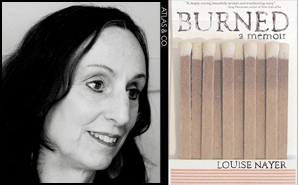 My mother, Dorothy D. Nayer, was severely burned in the basement of a Cape Cod cottage in the summer of 1954, when I was four and my sister, six. She suffered through 37 operations, mostly on her face. With incredible will and enormous strength, even though she was completely disfigured, she was determined to keep our family together. She set out to live the same life that she was living before the accident. She also continued to tirelessly work to change the field of nursing at a time when nurses were still considered handmaidens to doctors.
My mother, Dorothy D. Nayer, was severely burned in the basement of a Cape Cod cottage in the summer of 1954, when I was four and my sister, six. She suffered through 37 operations, mostly on her face. With incredible will and enormous strength, even though she was completely disfigured, she was determined to keep our family together. She set out to live the same life that she was living before the accident. She also continued to tirelessly work to change the field of nursing at a time when nurses were still considered handmaidens to doctors.
My mother put herself through school, receiving an MA in Nursing Education from Columbia Teacher’s College and finished all her coursework toward a PhD, at a time when few women even worked outside the home.
Determined to accomplish her goals, she gingerly stepped back into the world of work. She spent most of her career as an associate editor for The American Journal of Nursing. Although she had only practiced in a hospital for a couple of years, through her writing she never stopped trying to make things better for patients on the hospital floors. She praised her “special” nurse during the horror of her reconstructive surgeries who never asked my mother if she should come early to her surgeries—she always showed up to hold my mother’s hand down the dreaded hallways. Her plastic surgeon had a different attitude, stating, “If I gave my patients empathy, I couldn’t do my job.” She remembered these experiences. She knew firsthand what it meant when a nurse or doctor left the room and the patient’s tray was just slightly out of reach. In her career, my mother set out through her writing and talks with student nurses to make sure that empathy was freely given to all the patients in their beds. In an article about burn patients, my mother wrote, “If a patient wants to cry, let her cry. If she wants to be silent, let her be silent.”
Her passion for patient advocacy continued even after she retired. Once, she returned to the hospital again as a patient for a knee replacement and incurred a virulent staph infection that kept her in the hospital. One day, she found her roommate in obvious distress. She kept trying to get a nurse’s attention, to no avail. My mother picked up the phone and said to the head nurse on the other end of the line: “This is Dorothy Nayer. I’m a patient and an RN, and the woman in the next bed, I believe, has phlebitis and needs immediate attention.” Five minutes later, her roommate was transferred to a place where she got the care she needed.
Many stories continue to live on about my mother advocating for others and fighting for a better healthcare system. She lives in all the articles she wrote for The American Journal of Nursing and Nursing Times in London. Her enormous strength and contributions to the field of nursing even after her terrible accident are an inspiration to us all.

















